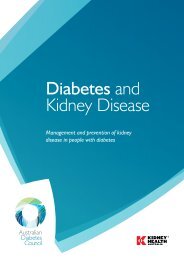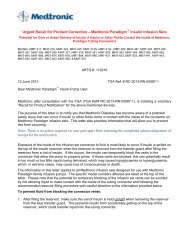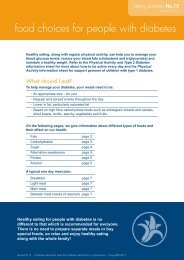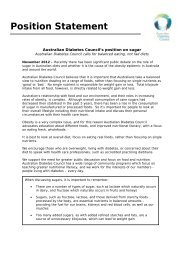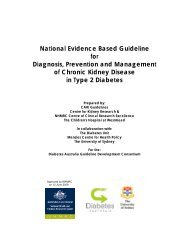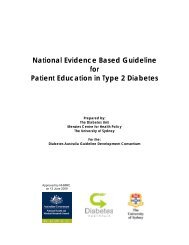O MeA e tAtAU OnA e IlOA - Australian Diabetes Council
O MeA e tAtAU OnA e IlOA - Australian Diabetes Council
O MeA e tAtAU OnA e IlOA - Australian Diabetes Council
Create successful ePaper yourself
Turn your PDF publications into a flip-book with our unique Google optimized e-Paper software.
Healthy eating for diabetes - continued<br />
What is healthy eating for diabetes?<br />
Healthy eating for diabetes is the same as healthy eating for everyone. A healthy eating<br />
pattern encourages:<br />
• High fiber cereals including wholegrain breakfast cereals, wholemeal or grainy breads,<br />
wholemeal pasta and brown rice.<br />
• Two serves of fruit and five or more serves of vegetables every day (e.g. bananas, paw<br />
paw, mangoes, breadfruit, pineapple, kumara, taro, cassava, cabbage, lu’au leaves). Include<br />
legumes such as baked beans, kidney beans, lentils, chick peas and split peas<br />
• One to two serves of lean meat, fish, skinless poultry or alternatives each day. Some great<br />
examples include fresh fish and seafood such as sashimi and shellfish. Alternative proteins<br />
include legumes, tofu, eggs, nuts and seeds.<br />
• Dairy foods (e.g. milk, cheese and yoghurt) that are low fat or skim for everyone over the<br />
age of two. Soy products fortified with calcium are a good alternative for those who cannot<br />
have dairy.<br />
• Limit saturated fat (e.g. coconut desserts, pe‘epe’e (a sauce made from coconut cream and<br />
onion) and supoesi (a breakfast soup made up with coconut cream and pawpaw), cakes,<br />
pastries, corned beef, pork crackling, mutton flap, fast food).<br />
• Have a low–moderate fat intake.<br />
• Avoid adding salt to food. Choose low salt or reduced salt foods. Limit salty foods such as<br />
salted corned beef, povi masima (salted beef brisket) and soy sauce<br />
• Eat only moderate amounts of sugars and limit or avoid foods high in added sugars (e.g.<br />
sweet pies, puddings, ice cream, sweets, fausi (a dessert made up with taro or pumpkin),<br />
soft drinks and fruit juice).<br />
• Drink plenty of water.<br />
• If you drink alcohol, limit your intake to 2 standard drinks a day. It will also be a good idea<br />
to include alcohol free days each week.<br />
How can I keep my blood glucose (sugar) levels in the healthy range?<br />
It is very important that people with diabetes aim to keep their blood glucose levels in target<br />
range with regular physical activity, healthy eating and appropriate treatment (medications<br />
and/or insulin if required).<br />
You can help to do this by spreading your food intake out over the day, not overdoing your<br />
serve sizes and choosing mostly high fibre, low fat and lower glycemic index carbohydrates.<br />
Regular reviews with your dietitian are important to help you get the balance right between<br />
your blood glucose levels, the food you eat, exercise and your diabetes medication, if you<br />
take them. A dietitian may suggest you make changes to the types of food you eat and how<br />
much you eat to help keep you healthy. Your dietitian will try to work within the foods and<br />
cooking methods that you traditionally use.<br />
26




